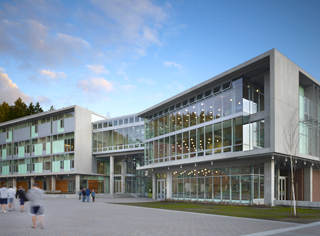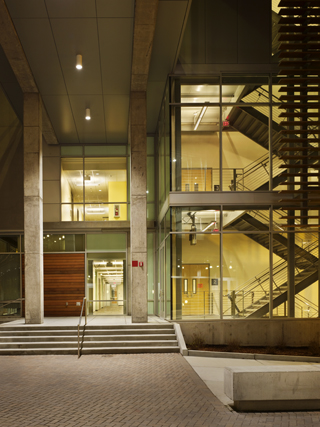
DJC.COM
August 20, 2009
Attention to detail makes WWU building unique
Special to the Journal

Bacon
|
Through the use of affordable construction materials and a streamlined design approach, the design team of Western Washington University’s new Academic Instructional Center in Bellingham has been able to deliver a building with a level of detail not typically found in academic projects.
The $50 million project houses the university’s department of psychology and department of communication sciences and disorders in two wings joined by a central covered passageway. The east wing includes faculty offices and other enclosed departmental spaces, while the more open west wing offers lecture halls, classrooms and public spaces.
The exterior of the 127,000-square-foot project is a complex combination of metal siding, full-story window systems, brick masonry veneer elements, precast concrete elements of varying shapes and sizes, and intricately detailed wood, steel and metal sunscreen assemblies.
The west wing’s airier design concept allows for natural ventilation. The strategic siting of the east wing takes advantage of a south wind to naturally cool perimeter faculty offices. The building’s orientation also allows for controlled daylighting.
The owner is pursuing LEED certification.
Concrete vs. steel

Photos by Ben Benschneider, courtesy of Coughlin Porter Lundeen Western Washington’s $50 million Academic Instructional Center has two wings joined by a fourth-floor skywalk. |
The AIC building’s structure is concrete instead of steel, a decision made after intense discussion. The decision allowed for the use of post-tensioned concrete floor slabs with concrete shear walls, a structural design style common in Class A office structures but less often used in university buildings.
The approach allows for longer, thinner floor spans with less material. Its use in the AIC building meant having more open floor plates while saving considerable time and money on building materials.
A drawback of post-tensioned flooring is the limited ability to penetrate the floors vertically without interfering with the post-tensioning tendons. The team was able to minimize this risk through careful planning and extensive tendon-location marking during construction.
Post-tensioned flooring also won out because, without deep floor plates typically seen in steel construction, the design was able to offer greater horizontal flexibility. Mechanical systems can be run with fewer encumbrances, and the inherent characteristics of concrete eliminate the need for fireproofing.
Highly designed

Steel framework supports a stairway that was also designed to support the storefront enclosure system. |
Perhaps the AIC’s most unique attribute is its high level of design and its intricate material connections both inside and out. Instead of leaving the design of these lighter elements to design-build subcontractors, the building’s structural engineering firm, Coughlin Porter Lundeen of Seattle, took on the task.
“Many of the softer elements are commonly designed by multiple engineers working for various subcontractors,” said Jim Coughlin, Coughlin Porter Lundeen principal.
“For this unique building, it made a great deal of sense of have the structural engineer of record take responsibility because so many unique combinations of elements required design integration and coordination.”
For example, steel framework supports the feature stair at the east end of the bridge that connects the two wings. It was also designed to support the storefront enclosure system and ipe wood sunscreens, which wrap it on two adjacent sides.
Precast concrete elements and their connections were designed to accommodate post-installed, post-tensioned stainless steel mesh sunscreen elements spanning two and three levels vertically within the precast “frames” visible on the south sides of each wing. Metal stud backing behind the cedar siding was supported by a steel framework cantilevered from the post-tensioned slab below to allow windows to wrap over the walls.
“A high level of design has been achieved both architecturally and structurally by the two disciplines working so closely together during the design phase,” said Mark Gifford of NAC|Architecture of Seattle, the project’s executive architect.
With Coughlin Porter Lundeen’s involvement in the creation of the building’s many detailed and custom elements, a tight working relationship was formed between Coughlin Porter Lundeen, NAC and Opsis Architecture of Portland, the design architect. This high level of involvement led to highly detailed construction documents for the builders and, as a result, practically no change orders.
“With its unique combination of systems, this was a good example of how an integrated design team saves the owner money, helps the contractors expedite construction and achieves a high quality level,” Coughlin said.
The building design drove the design of the basic structure. The design team started with the desired aesthetic of the precast concrete geometry, the bridge, and the interior and exterior feature elements and worked the structure to accommodate. Precast corner conditions required column geometry and location adjustments. The exposed cast-in-place and precast concrete required slab notching and intricately designed connections. Temporary openings in slabs and shear walls were designed and detailed to provide access to make connections during construction.
“This level of refinement would have been extremely difficult to achieve with a subcontractor design-build approach,” Coughlin said.
Natural heating, cooling
While both wings of the building are designed to incorporate natural ventilation and daylighting, the west building offers more dramatic design features. Its program — with classrooms, public gathering areas and other large spaces — allows for a cooling and heating system that relies very little on electricity. Air is brought into the building through the louvers on the lower windows and warms as it passes through the building, Gifford said.
When it hits the vertical shafts, it rises up. When it reaches the top, sensors detect the air’s temperature and carbon dioxide level, and automatic actuators open the windows when necessary.
The interior walls are constructed using concrete masonry units, which absorb heat. At night, the windows are opened and the building is flushed with outside air, which cools the concrete structure and, in turn, cools the interior.
The design integration practiced throughout the building was most evidently demonstrated in the design of this and other natural ventilation components. The CMU walls were actually partial height, with the tops of the walls stopping several feet below the slab above to allow for open air flow. Steel elements cantilever down from the slab above to provide seismic support.
The building’s unique exterior materials were selected to include elements from surrounding campus buildings, said Gil Aiken, WWU’s project manager.
Brick veneer was employed to match the adjacent communications facility, and solar shading louvers match those of the nearby Wade King Student Recreation Center.
The Academic Instructional Center’s design seems to resonate with students. Since it opened in January, the collaborative study areas — including the skybridge between the two building wings — have seen a high use rate, Aiken said.
Sheila Bacon is a Seattle-based freelance writer and communications consultant for Coughlin Porter Lundeen and other architecture, engineering and construction industry firms.
Other Stories:
- My epiphany on learning: It’s the method, not the content
- South Shore campus will create a hub for the community
- Medina school celebrates cycles of nature, learning
- Architects add a new role to their job duties: facilitator
- Bouncing sounds make lecture halls tricky to design
- 7 things you need to know to build a better stage
- Robert Frost Elementary design takes road less traveled
Copyright ©2009 Seattle Daily Journal and DJC.COM.
Comments? Questions? Contact us.